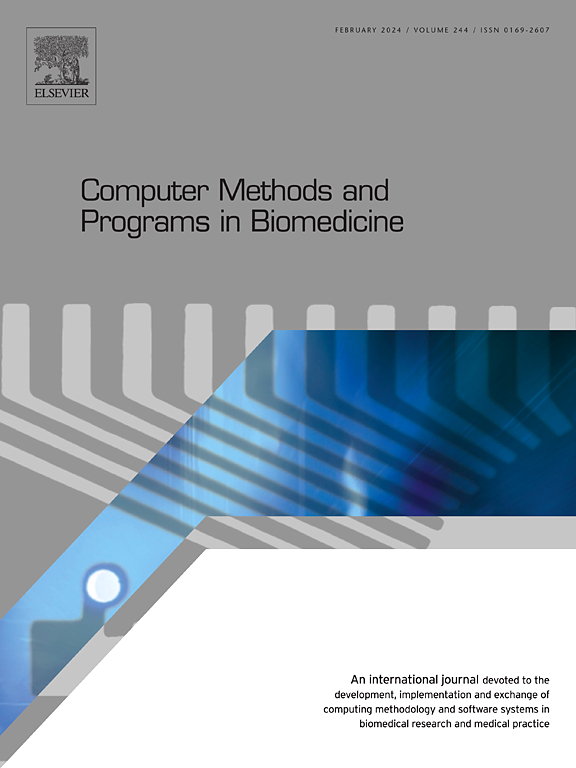Development and validation of an explainable model of brain injury in premature infants: A prospective cohort study
IF 4.9
2区 医学
Q1 COMPUTER SCIENCE, INTERDISCIPLINARY APPLICATIONS
引用次数: 0
Abstract
Background:
Preterm brain injury (PBI) is a prevalent complication in preterm infants, leading to the destruction of critical structural and functional brain connections and placing a significant burden on families. The timely detection of PBI is of paramount importance for the prevention and treatment of the condition. However, the absence of specific clinical manifestations in the early stages of PBI renders it susceptible to misdiagnosis and missed diagnoses. Moreover, once it occurs, there is no specific treatment available. The aim of this study was to develop and validate a machine learning (ML) based interpretable model for the early detection of PBI, as well as the assessment of patient-wide and individual risk factors for this disease.
Methods:
This study utilized a cohort of premature infants provided by Northwest Women’s and Children’s Hospital in China, comprising medical records of 650 premature infants, spanning from 2019 to 2021. PBI were identified based on cranial magnetic resonance imaging (MRI). Fourteen machine learning models were employed with stratified 10-fold cross-validation method used to evaluate model performance. The Shapley Additive Explanations (SHAP) method was applied for model interpretation. Feature selection methods were used to determine the final model which was validated on the independent test set. Subsequently, risk factors for the entire cohort and individual patients were assessed.
Results:
Among the fourteen machine learning models, the CatBoost model demonstrated the best discriminative ability. Following feature selection, the final model was constructed using seven features, designated as PBIPred (Preterm Brain Injury Predictor). PBIPred exhibited strong performance in both 10-fold cross-validation and independent test set (AUC = 0.8229) for accurately predicting PBI. The screening for risk factors in the cohort and individuals identified the following variables as positive risk factors for PBI: Mechanical ventilation (MV), Weight, Anemia of prematurity (AOP), Respiratory distress syndrome (RDS), Albumin (ALB), and White blood cell (WBC).
Availability and implementation:
The PBIPred webserver and PBIPred tool were developed for clinical diagnosis and large-scale local medical record data prediction. They can be accessed freely at http://pbipred.liaolab.net and https://github.com/chikit2077/PBIPred, respectively.
一个可解释的早产儿脑损伤模型的发展和验证:一项前瞻性队列研究。
背景:早产儿脑损伤(PBI)是早产儿常见的并发症,可导致关键结构和功能脑连接的破坏,并给家庭带来重大负担。及时发现PBI对于预防和治疗PBI至关重要。然而,PBI早期缺乏特异性临床表现,容易误诊和漏诊。此外,一旦发生,没有特定的治疗方法。本研究的目的是开发和验证基于机器学习(ML)的可解释模型,用于PBI的早期检测,以及评估该疾病的患者范围和个体风险因素。方法:本研究采用中国西北妇幼医院提供的早产儿队列,包括2019 - 2021年650例早产儿的医疗记录。颅脑磁共振成像(MRI)诊断PBI。采用分层10倍交叉验证法对14个机器学习模型进行性能评估。采用Shapley加性解释(SHAP)方法进行模型解释。采用特征选择方法确定最终模型,并在独立测试集上进行验证。随后,对整个队列和个体患者的危险因素进行评估。结果:在14个机器学习模型中,CatBoost模型表现出最好的判别能力。在特征选择之后,使用7个特征构建最终模型,命名为PBIPred (Preterm Brain Injury Predictor)。PBIPred在10倍交叉验证和独立检验集(AUC = 0.8229)中均能准确预测PBI。对队列和个体的危险因素筛查确定了以下变量为PBI的阳性危险因素:机械通气(MV)、体重、早产儿贫血(AOP)、呼吸窘迫综合征(RDS)、白蛋白(ALB)和白细胞(WBC)。可用性和实施:PBIPred网络服务器和PBIPred工具是为临床诊断和大规模本地病历数据预测而开发的。它们可以分别在http://pbipred.liaolab.net和https://github.com/chikit2077/PBIPred上免费访问。
本文章由计算机程序翻译,如有差异,请以英文原文为准。
求助全文
约1分钟内获得全文
求助全文
来源期刊

Computer methods and programs in biomedicine
工程技术-工程:生物医学
CiteScore
12.30
自引率
6.60%
发文量
601
审稿时长
135 days
期刊介绍:
To encourage the development of formal computing methods, and their application in biomedical research and medical practice, by illustration of fundamental principles in biomedical informatics research; to stimulate basic research into application software design; to report the state of research of biomedical information processing projects; to report new computer methodologies applied in biomedical areas; the eventual distribution of demonstrable software to avoid duplication of effort; to provide a forum for discussion and improvement of existing software; to optimize contact between national organizations and regional user groups by promoting an international exchange of information on formal methods, standards and software in biomedicine.
Computer Methods and Programs in Biomedicine covers computing methodology and software systems derived from computing science for implementation in all aspects of biomedical research and medical practice. It is designed to serve: biochemists; biologists; geneticists; immunologists; neuroscientists; pharmacologists; toxicologists; clinicians; epidemiologists; psychiatrists; psychologists; cardiologists; chemists; (radio)physicists; computer scientists; programmers and systems analysts; biomedical, clinical, electrical and other engineers; teachers of medical informatics and users of educational software.
 求助内容:
求助内容: 应助结果提醒方式:
应助结果提醒方式:


